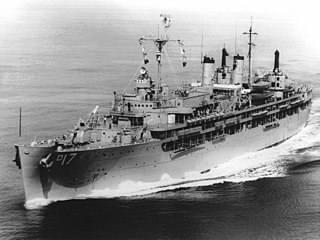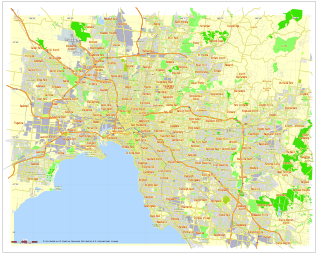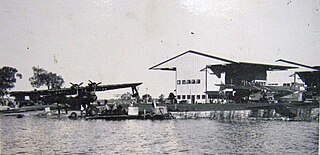
The United States Asiatic Fleet was a fleet of the United States Navy during much of the first half of the 20th century. Before World War II, the fleet patrolled the Philippine Islands. Much of the fleet was destroyed by the Japanese by February 1942, after which it was dissolved, and the remnants incorporated into the naval component of the South West Pacific Area command, which eventually became the Seventh Fleet.

USS New Orleans (CL/CA-32) was the lead New Orleans-class cruiser in service with the United States Navy. The New Orleans-class cruisers were the last U.S. cruisers built to the specifications and standards of the Washington Naval Treaty of 1922. Such ships, with a limit of 10,000 long tons (10,160 t) standard displacement and 8-inch (203-millimetre) calibre main guns may be referred to as "treaty cruisers." Originally classified a light cruiser, because of her thin armor, she was reclassified, soon after being laid down, a heavy cruiser, because of her 8-inch guns. The term "heavy cruiser" was not defined until the London Naval Treaty in 1930.

The third USS Dale (DD-290) was a Clemson-class destroyer in the United States Navy. She was named for Richard Dale.

John Duncan Bulkeley was a vice admiral in the United States Navy and was one of its most decorated naval officers. Bulkeley received the Medal of Honor for actions in the Pacific Theater during World War II. He was also the PT boat skipper who evacuated General Douglas MacArthur from Corregidor in the Philippines and commanded at the Battle of La Ciotat.

USS O'Bannon (DD/DDE-450), a Fletcher-class destroyer, was the second ship of the United States Navy to be named after Lieutenant Presley O'Bannon (1784–1850), the Marine Corps's "hero of Derna".

The Philippines campaign, also known as the Battle of the Philippines or the Fall of the Philippines, was the invasion of the Philippines by the Empire of Japan and the defense of the islands by United States and the Philippine Armies during World War II. It took place between December 8, 1941 and May 8, 1942.

USS Parrott (DD-218) was a Clemson-class destroyer in the United States Navy during World War II and was the second ship named for George Fountain Parrott.

USS Bulmer (DD-222/AG-86) was a Clemson-class destroyer in the United States Navy during World War II. It was the last warship of the Asiatic Fleet in USN commission.

USS Stewart (DD-224) was a Clemson-class destroyer in the United States Navy during World War II. She was the second ship named for Rear Admiral Charles Stewart. Scuttled in port at Surabaya, Java, she was later raised by the Japanese and commissioned as Patrol Boat No. 102. She came back under American control in 1945 after the occupation of Japan.

USS Putnam (DD-287) was a Clemson-class destroyer in the United States Navy following World War I. She was named for Charles Putnam.

USS Young (DD-580), a Fletcher-class destroyer, was the second ship of the United States Navy of that name. She was the first to be named for Rear Admiral Lucien Young (1852–1912).
Destroyer minesweeper was a designation given by the United States Navy to a series of destroyers that were converted into high-speed ocean-going minesweepers for service during World War II. The hull classification symbol for this type of ship was "DMS." Forty-two ships were so converted, beginning with USS Dorsey (DD-117), converted to DMS-1 in late 1940, and ending with USS Earle (DD-635), converted to DMS-42 in mid-1945. The type is now obsolete, its function having been taken over by purpose-built ships, designated as "minesweeper (high-speed)" with the hull classification symbol MMD.

USS Piedmont (AD–17) was a Dixie-class destroyer tender built during World War II for the United States Navy. Her task was to service destroyers in, or near, battle areas and to keep them fit for duty. She served in the Pacific Ocean during World War II, the Cold War, the Korean War, and the Vietnam War. For her work in battle areas, the ship was awarded four battle stars for her Korean War efforts and one for Vietnam War service.

USS Mizar (AF-12) was the United Fruit Company fruit, mail and passenger liner Quirigua that served as a United States Navy Mizar-class stores ship in World War II.

Banana boat is a descriptive nickname that was given to fast ships, also called banana carriers, engaged in the banana trade. They were designed to transport easily spoiled bananas rapidly from tropical growing areas to North America and Europe. They often carried passengers as well as fruit.

Naval Base Milne Bay, also called Naval Advance Base Milne Bay, was new major United States Navy sea and airbase base built on Milne Bay in Milne Bay Province in south-eastern Papua New Guinea. By spring 1943, the build up of the US Navy to support the Pacific War had caused overcrowding at the ports on the east coast of Australia. To help, Seabees departed Naval Base Brisbane on June 19, 1943 to set up a new base in Milne Bay. Naval Base Milne Bay headquarters was at Ladava Navy Base. The Royal Australian Navy already had a small base in Milne Bay: HMAS Ladava. Australians were able to defend and keep Milne Bay in the Battle of Milne Bay in 1942. Naval Base Milne Bay was built during World War II to support the many ships and aircraft fighting and patrolling in the South West Pacific theatre of war. Ladava Navy Base provided a large protective US Navy fleet anchorage at Gahora Bay next to Ladava. At Naval Base Milne Bay, Seabees built a large Naval facility.

Naval Base Manila, Naval Air Base Manila was a major United States Navy base south of the City of Manila, on Luzon Island in the Philippines. Some of the bases dates back to 1898, the end of the Spanish–American War. Starting in 1938 civilian contractors were used to build new facilities in Manila to prepare for World War II. Work stopped on December 23, 1941, when Manila was declared not defendable against the Empire of Japan southward advance, which took over the city on January 2, 1942, after the US declared it an open city. US Navy construction and repair started in March 1945 with the taking of Manila in the costly Battle of Manila ending on March 2, 1945. Naval Base Manila supported the Pacific War and remained a major US Naval Advance Base until its closure in 1971.

Naval Base Melbourne was a United States Navy base at Melbourne during World War II. Naval Base Melbourne became the South West Pacific Area Command Headquarters after the 1941 invasion of the Philippines. General Douglas MacArthur, after escaping the Philippines, set up his Headquarters after his arrival on 21 March 1942. MacArthur was appointed Supreme Commander of all Allied Forces in the South West Pacific Area. The US Navy also set up a Headquarters a Melbourne, Allied Naval Forces Southwest Pacific Area under Commander Vice Admiral Herbert F. Leary. MacArthur and Leary used the empty Trustees Executive building at 401 Collins Street, Melbourne for headquarters. The Port of Melbourne had good fleet anchorage and docks. A new naval base was built at Brisbane, Australia, Naval Base Brisbane, and the Headquarters was moved to Brisbane in July 1942.

Naval Base Perth was a United States Navy base near Perth, Western Australia during World War II. Perth was selected as the site for a U.S. Navy base as it was beyond the range of Japanese long-range bombers. The Bombing of Darwin on 19 February 1942 demonstrated a more southern port was needed. Both existing port facilities and new bases were built at Perth. Naval Base Perth's Fleet Post Office # was 255 SF Perth, Australia.

US Naval Base Philippines was number of United States Navy bases in the Philippines Islands in the Pacific Ocean. Most were built by the US Navy Seabees, Naval Construction Battalions, during World War II. The US Naval Bases in Philippines were lost to the Empire of Japan in December 1941 during the Philippines campaign of 1941–1942. In February 1945 the United States Armed Forces retook the Philippines in the Battle of Manila in 1945. Before the captured US bases on Luzon were retaken the US Navy Seabees built a new large base, Leyte-Samar Naval Base, on the Philippine Island of Leyte, starting in October 1944.



















